Quick search
CTRL+K
Quick search
CTRL+K
The verdant Boriano canyon, more commonly referred to as Karanou Gorge, begins in the Boriana neighborhood of Karanou village and extends for 1800 meters until it merges with the Mavropiliotis River via an attractively laid out path. The trail features a dilapidated watermill, caves, and the entrances to the old iron ore quarries (locally referred to as the Averof quarries), along with a charcoal furnace and tunnels. The gorge runs parallel to the Kydoni Gorge, and it’s common for hikers to explore both gorges simultaneously.
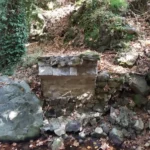
In the mountainous region of Kydonia near Chania, nestled at the base of the White Mountains, you’ll find the picturesque Kydoni gorge. Named after the area, not the Greek word for “quince” which is also kydoni, this gorge is one of the most verdant in Crete, boasting lush vegetation with trees towering over twenty meters high. The journey begins in the village of Karanou, starting at the site of an ancient fountain. A downhill path takes you through a breathtaking centuries-old olive grove, past the church of Saint Demetrius (Agios Dimitrios) with its remnants of old frescoes, and finally to the stream bed. The greenery is abundant throughout the gorge, with sunlight only filtering through in a few places, making it a perfect spot for a cool walk on a hot, sunny day.
The trail that traverses the gorge is one of the most well-marked in Crete, with signs posted every 500 meters indicating the distance. The entire route is 2 km long, ending where the Kydoni stream meets the Platanias river tributary, Mavropiliotis, in the Mavra Pila area. The name Mavra Pila translates to “dark muddy soil” in the Cretan dialect, a fitting description for the blackish soil that turns into black mud when wet.
The trail continues from the end of the Kydoni gorge into the Boriano gorge, which runs parallel to Kydoni and originates from the Boriana neighborhood in Karanou. The Kydoni stream is typically dry throughout the year, only filling with water during the heavy rains of winter. Along the route, there are 2-3 small waterfalls, with the tallest one crossed by a charming wooden bridge that leads to a rock shelter adorned with small stalactites. The descent through Kydoni takes about an hour of hiking. Towards the bottom of the gorge, you’ll find two old trails leading to the nearby settlement of Skordalou.

Situated close to the village of Meskla, 20 km away from Chania town and nestled at the foot of the White Mountains, you’ll find the impressive yet compact Sarakina Gorge (be careful not to mix it up with the other well-known Sarakina Gorge in East Crete, near Mythi in the Province of Ierapetra). The gorge takes its name from local lore that suggests Saracenes once used it as a hiding place. The gorge’s somewhat elusive location keeps it off the beaten track for many locals, maintaining its status as an untouched, natural spectacle.
Hidden within a deep ravine, Sarakina is bordered by towering cypress and plane trees. In an effort to make this natural gem more accessible, local authorities have developed walking trails throughout the gorge. Starting and ending in Meskla, next to the Church of the Panagia, where you find the parking space. The circular trail offers an hour’s worth of easy hiking. The journey commences with a ten-minute walk on a dirt road which then leads to a path alongside the river.
The trail is interspersed with wooden and stone staircases and metal walkways crossing the river. After the first segment, the landscape transforms drastically, transitioning from a gravel bed to solid limestone boulders. The resulting view is an awe-inspiring natural artwork as the rock appears split down the middle, carving out a breathtaking sculpture.
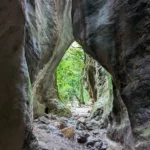
Positioned near the city of Chania, the Therisso Gorge (also known as Eleftherios Venizelos) is an awe-inspiring sight. This six-kilometre-long canyon is adorned with impressive vertical cliffs and lush greenery, rivalling any other gorge in the Chania region. Accessible by car, it’s worth combining a trip to the gorge with a visit to the historic village of Therisso, nestled at the foot of the White Mountains, just 15 kilometres from Chania. This village, steeped in history, offers an unforgettable experience to any visitor.
With a population of just over 100, the valiant village of Therisso has held a significant role in Crete’s modern history, mainly due to the resilience of its inhabitants against Turkish invasions. In 1866, the village was burnt by Mustapha Pasha Naili, forcing many, including the mother of future Greek Prime Minister, Eleftherios Venizelos, to relocate to Kythera and the Peloponnese. Therisso gained further historical prominence in 1905 when Eleftherios Venizelos and his allies initiated a revolution against the autocratic rule of Prince George, imposed by the Great Powers, charting a course for Crete’s union with Greece. Notably, the heroic Halides brothers, key figures in the 1821 revolution, also hailed from Therisso.

The Prasses or Askidia canyon is nestled within the forested area of the White Mountains. The exit of this canyon is situated close to the Askidia village (at an elevation of 480m), which is a section of the Prasses village, hence the dual names. To find the beginning of the canyon, you need to drive on the road from Chania to Sougia, then take a turn at Petras Seli intersection that leads to Omalos Plateau. After approximately 1.5km past the turnoff to Omalos, you will come across a dirt road and footpath that lead to the Platanos area. This region is captivating with its ferns, plane trees, and water springs. It is also the starting point of the lush Prasses canyon, a journey that takes roughly 2 hours.
The gorge boasts striking vertical walls and is surrounded by a thick pine forest (the northernmost in the Chania prefecture). This, combined with the river bed’s deciduous trees (such as maples and sycamores), creates a stunning landscape, particularly in the fall. The canyon is perfect for leisurely hikes along its riverbed, taking photos, and bird watching. Additionally, there are 2-3 small caves along the walls. Upon exiting the gorge, you will encounter the tiny hamlet of Askidia, concealed within a thick chestnut forest. If you don’t have a car, an additional half-hour walk will take you to the picturesque Prasses village.
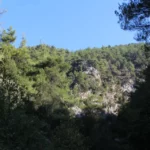
The Tromarissa Gorge, named after local legends of fairies and goblins that frightened passersby, is situated close to the village of Zourva. The spring of Tromarissa, which translates to ‘scare’ in Greek, is where these tales are said to originate.
Beginning beneath the Agavani peak of the White Mountains, this technical canyon concludes near Zourva, with the Ambelitsiotis River (also known as Zourvanos) flowing alongside it. A hiking trail passes through the gorge, with additional trails stemming from the spring area towards the White Mountains and Pera Gourgouthes. The stream’s course features around 40+ medium-height rappels (waterfalls), the tallest of which is 17m. It takes a small group of canyoneers approximately six hours to traverse the gorge. The Chania Mountaineering Club (ΕΟΣ Chania) has secured the descents to Zourva with double bolts.

The Cyclamen Gorge, also known as Agios Georgios Gorge or Gorge Vandes, is nestled on the northern slopes of the White Mountains. Its starting point is the Aletrouvari settlement, situated at an altitude of 300m, and it extends east of Agios Georgios village, ultimately ending at the village of Vandes, which is at an elevation of 50m. The stream that runs through this gorge gathers water from the Drakona area, resulting in the formation of quaint, small ponds at certain spots.
However, this route is not recommended for novice hikers as it requires approximately 2 hours to traverse from Aletrouvari or about 1 hour from Agios Georgios. As visitors journey through this route, they will encounter a diverse landscape that changes along the river, all under the cool shade of towering plane trees and cypresses.

The Vavouledo canyon begins approximately 1km east of Hamalevri village, where the Hortes stream flows. A path follows the length of the canyon. Close to Lidiana village, the canyon merges with the Trahinos Gorge, and the combined river continues to the “cosmopolitan” district of Palea Roumata, Arhontika. Here, you’ll find taverns where you can enjoy a meal.
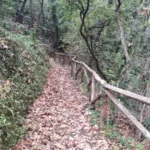
Located about 35km southwest of Chania city, on the northern slopes of Mount Apopigadi, Palea Roumata is a verdant area. This region is made up of 13 neighborhoods, all part of the same village (Palea Roumata), spread across the slopes. Near the small settlement of Lidiana, the Vavouledo and Trachinos canyons converge, providing an ideal circular route with water until late spring.
The Trahinos Gorge, starting near the Trahinos hamlet, is fairly short but stands as one of Crete’s greenest gorges. Its walls are so narrow that they’re almost unnoticeable from above. The gorge is filled with dense vegetation, often casting shadows over the riverbed. Similar to Vavouledo, the Trahinos Gorge also features a hiking trail.
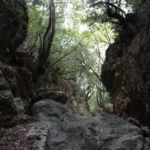
Fygou Gorge, a small yet stunning sub-gorge of the renowned Agia Irini Gorge, is situated near Sougia. This narrow canyon played a significant role in history, serving as an escape route for local rebels to the Sfakia mountains during various revolutions, hence its name ‘Fygou’, meaning escape.
In present times, many trekkers embarking on the Agia Irini Gorge trail, the second most popular gorge in Crete after Samaria, choose to commence their journey from Fygou Gorge. After approximately an hour of walking, they meet the Agia Irini Gorge.
A beautiful path winds through Fygou, weaving between a picturesque cypress and pine grove. An abandoned settlement and a Forest Service outpost can be found at the location known as Polla Spitakia. Near the point where Fygou Gorge meets the Agia Irini Gorge, the historic Hirotrypa cave is located. This site marks a tragic event from 1822 when two local hermits were murdered by the Ottomans.
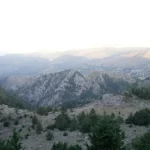
Situated on the western flank of the White Mountains in the Selino province, the Agia Irini gorge owes its name to the nearby village of Agia Irini (Saint Irene), a mere 46 km from Chania.
The trail of Agia Irini Gorge commences just below the Agia Irini village and concludes at the Oasis Taverna. The track, which descends approximately 500 meters, extends for 7.5 km and requires nearly three hours to navigate. It is a well-preserved and predominantly shaded path, embellished with pine trees, plane trees, and oleander bushes.
The journey from the exit of the gorge to the village of Sougia covers about 5 km along a lightly used road with scarce shade. On sweltering days, arranging transportation to Sougia is recommended. The gorge, which is open all year round, is graced with a small river, but certain sections may become inaccessible or dangerous after heavy rain. From April to October, during the tourist season, a nominal fee is collected at the entrance (or exit for those hiking uphill) of the gorge. This fee aids in maintaining the path, collecting trash, and general upkeep to ensure a pleasant experience for all visitors.
The gorge forms part of the European footpath E4. Its southern entrance is positioned 5 kilometers north of Sougia. It is included in the NATURA 2000 protected areas and has been declared a wildlife reserve by the Ministry of Agriculture. The gorge is home to the endangered Cretan ibex, agrimi, and boasts a variety of microenvironments and habitats for an array of wildlife species. The diverse flora, including trees (cypress, pine, maple, plane, oak, holm oak), shrubs, brushwoods, and fine herbs such as dittany, is of significant importance.
The gorge holds immense significance, not only for its rich biodiversity and aesthetic appeal but also for its historical and cultural significance. At the “Polla Spitakia” area within the gorge, rebels found refuge from the Ottomans. This is where the “Fygou” path begins, which served as an escape route from the gorge to the Omalos plateau. The area houses the Byzantine Church of Christ (1358 AD) and the dilapidated church of Saint George (1460 AD). The gorge, second in popularity to Samaria in the Chania prefecture, remains open for a longer duration.
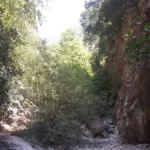
No results available
ResetNo results available
Reset© All rights reserved. Crete Locals